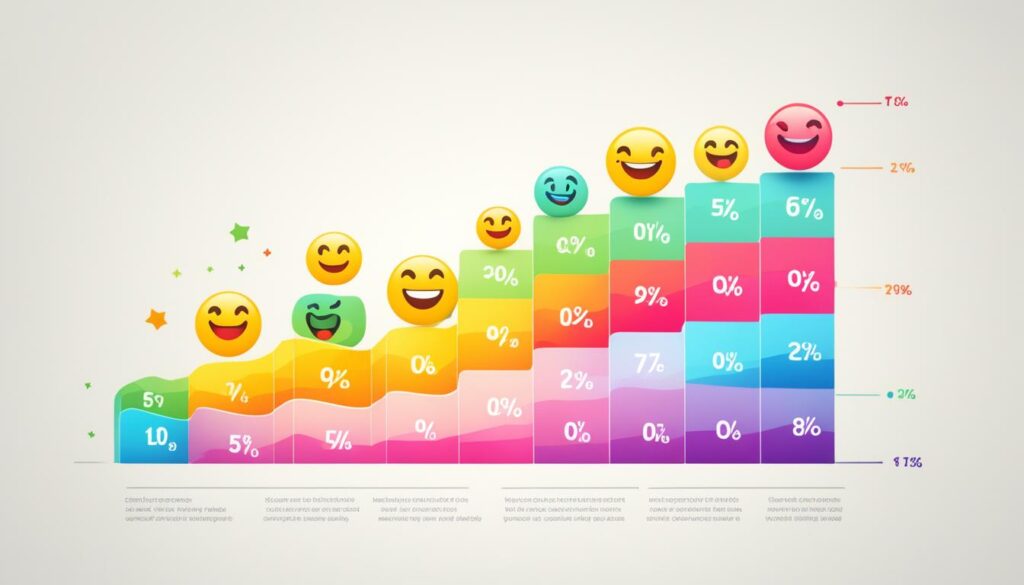Measuring customer satisfaction is essential for business success. Studies have shown that 80% of customers will switch to another company after just one poor service experience. But measuring customer satisfaction doesn’t have to be complicated or expensive. In this section, we will explore the steps to effectively measure customer happiness, including defining goals, outlining a plan, choosing a customer satisfaction survey type, customizing the survey layout and questions, determining the survey’s trigger, and analyzing survey data.
Define Your Goals to Measure Customer Satisfaction
The first step in measuring customer satisfaction is to define your goals. Ask yourself why you are measuring customer satisfaction and what you hope to achieve. Having a clear goal in mind will help you make the most of the customer data you collect. It’s important to use this information to improve your business and take action when you see a segment of customers who are unsatisfied.
“Defining your goals ensures that you have a direction and purpose for measuring customer satisfaction. It allows you to focus on specific areas of improvement and track progress over time.”
Customer satisfaction goals can include measuring customer loyalty, assessing feedback, and establishing a customer happiness index. By determining the key metrics you want to track, you can effectively measure the level of satisfaction your customers have with your products or services.
Once you have clear goals in place, you can design your survey questions and data analysis methods to capture the information most relevant to your objectives. Defining your goals sets the foundation for a successful customer feedback measurement strategy.
Outline Your Plan for Measuring Customer Satisfaction
Now that you have defined your goals, it’s time to outline a solid plan for measuring customer satisfaction. This plan will serve as your roadmap, guiding you towards enhancing the customer experience based on the feedback and data you gather.
One crucial aspect of your plan is customer sentiment tracking. By monitoring customer sentiments, you can identify any bottlenecks in the customer experience and take proactive steps to improve them. For example, if a specific feature or process consistently receives negative feedback, you can prioritize addressing it to enhance customer satisfaction.
In addition to addressing pain points, it is essential to expedite support interactions with dissatisfied customers. By providing timely responses and resolutions, you can turn a potentially negative experience into a positive one. Consider implementing live chat support to offer immediate assistance to customers, increasing their satisfaction levels.
Another valuable strategy to include in your plan is implementing proactive support measures. Creating a comprehensive knowledge base can empower customers to find answers to their questions without needing to reach out for support. By anticipating their needs and providing self-service resources, you can increase customer happiness and reduce their effort in resolving issues.
To further optimize the customer experience, test different live chat scripts and support strategies. This allows you to identify the most effective approaches to enhance customer satisfaction, based on real-time feedback and data.
“Your plan for measuring customer satisfaction should encompass customer sentiment tracking, expedited support interactions, proactive support measures, and testing different live chat scripts and support strategies.”
By outlining a comprehensive plan for measuring customer satisfaction, you can stay proactive in addressing customer needs and continuously enhancing their experience.

Choose the Right Customer Satisfaction Survey Type
Choosing the right type of customer satisfaction survey is crucial for effectively measuring customer happiness. It enables you to gather valuable insights and feedback to enhance the customer experience. There are several survey methodologies to consider:
- Customer Satisfaction Score (CSAT): This survey measures overall satisfaction by asking customers to rate their experience on a scale, typically from 1 to 5, or using smiley faces or thumbs up/down icons.
- Customer Effort Score (CES): CES surveys assess the ease of the customer experience by asking customers how much effort they had to exert to achieve their goals, often on a scale from 1 to 7.
- Net Promoter Score (NPS): NPS surveys measure the likelihood of customers recommending your product or service to others. Customers are asked how likely they are to recommend using a scale from 0 to 10, and are then categorized into Promoters, Passives, and Detractors based on their score.
- Customer Satisfaction Index (CSI): CSI surveys assess satisfaction with specific attributes of a product or service. This type of survey allows you to gather feedback on areas such as customer support, product quality, or delivery speed.
Remember, it’s important to select the survey type that aligns with your goals and provides the most relevant insights for your business. Each survey methodology focuses on different aspects of customer satisfaction and can provide unique perspectives on how to improve the customer experience.
Once you have chosen the appropriate survey type, you can proceed to customize the survey layout and questions to gather the most valuable data. Analyzing the survey data will help you identify areas for improvement and make data-driven decisions to enhance customer satisfaction.

Customize Your Survey and Analyze the Data
Now that you have selected the perfect customer satisfaction survey type, it’s crucial to customize the survey layout and questions to gather the most valuable data. Remember, a concise survey is key, so include a mix of rating-scale and open-ended questions to get a comprehensive understanding of customer sentiment. Make sure each question serves a purpose and will provide meaningful insights for your business.
Once the surveys are complete, the real magic happens when you start analyzing the data. Look closely for patterns and trends in customer feedback, as they can unveil hidden opportunities for improvement. Pay attention to both quantitative and qualitative data. While numbers give you an overview, qualitative feedback from open-ended questions allows you to dive deeper into customer sentiment and gain crucial insights.
By customizing your survey to gather relevant information and analyzing the data thoroughly, you can gain a comprehensive understanding of your customers’ satisfaction levels. Armed with these insights, you can make data-driven decisions to enhance the customer experience and drive business growth. Remember, customer feedback measurement is not just about collecting data; it’s about using that data to create positive change.
FAQ
Why is measuring customer satisfaction important?
Measuring customer satisfaction is essential for business success as studies have shown that 80% of customers will switch to another company after just one poor service experience.
What are some goals you can define when measuring customer satisfaction?
Some goals you can define when measuring customer satisfaction include measuring customer loyalty, assessing feedback, and establishing a customer happiness index.
How do you outline a plan for measuring customer satisfaction?
To outline a plan for measuring customer satisfaction, identify key bottlenecks in the customer experience, work to improve them, expedite support interactions with dissatisfied customers, and implement proactive support measures like a knowledge base or testing different live chat scripts and support strategies.
Which survey types can be used to measure customer satisfaction?
Customer Satisfaction Score (CSAT), Customer Effort Score (CES), Net Promoter Score (NPS), and Customer Satisfaction Index (CSI) are popular survey methodologies to consider.
How should a customer satisfaction survey be customized and analyzed?
Customize the survey layout and questions, keeping it concise with a mix of rating-scale and open-ended questions. Analyze the survey data by looking for patterns and trends in customer feedback, and utilize qualitative, open-ended questions to gather additional insights.
